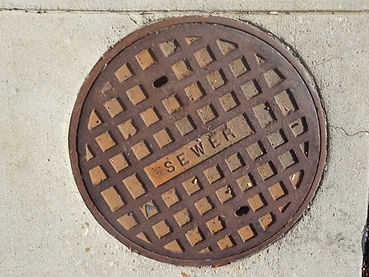working to make science better For the 118 indvidual WIS elements, GO to MORE in the menu above . . .




Iron Fe
Where is iron used--or where does it impact our everyday lives?
Used for construction, man-hole covers and many other uses.
Iron Symbol: Fe
Atomic number: 26 Atomic Mass: 55.8
Group number: 8 Period number: period 4
Transition metal
Melting point: 2,800oF (1,538oC)
Boiling point: 5,184oF (2,862oC)
Reaction with air: Iron metal reacts in moist air 4Fe + 3O2 --> 2Fe2O3
Reaction with water: iron metal reacts in moist air by oxidation rust, iron III oxide. Electron configuration [Ar] 3d6 4s2
Source: LANL.gov
Researcher: Siham A
Iron is a necessary micronutrient, needed in our diets.
Adults have 3-4 g iron in their bodies mainly in haemoglobin in red-blood cells. See dietary details of iron from the FDA: Iron in your body
Some breakfast cereals contain the daily allowance in each serving--check out your breakfast cereal!
Iron is made in a blast furnace, where a blast of hot air (oxygen) reacts with carbon in coal to form carbon monoxide. This carbon monoxide reduces iron ore (iron III oxide) to iron
2C + O2 --> 2CO
Fe2O3 + 3CO --> 2Fe + 3CO2This produces pig iron--named for the molds which looked like piglets feeding from the sow. There is 4% C in the iron, so it lacks strength. If it is reworked it becomes wrought iron.
Art teacher, Ms. T's grandmother used this flatiron to press clothes. Also called a "sad" iron--where sad means solid. The base is a solid block of iron. The wooden handle is removable and can be detached when the base is warming on a stovetop. Ms. T's grandmother had two bases and one handle because the second base was in use while one was heating. This iron is from the Colebrookdale Iron Co. in Pennsylvania.


Pictures of wrought iron art work and fences later!
When the carbon % decreases to about 2%, it becomes cast iron. Still brittle, cast iron is used for man-hole covers and grates--see images on left of the gratings and drain covers outside the Carriage House at WIS
WIS Photographer




With a great knowledge of World War II armaments, Robert H is in front of the WW II battleship USS New Jersey. Many WW II battleships were made of alloys of nickel, chromium and molybdenum in an alloy similar to St52, a steel alloy with about 4% nickel (Ni), 2% chromium (Cr), < 1% carbon (C). < 1% manganese (Mn) and sometimes a trace (0.2%) of molybdenium (Mo). .Also shown is the the Fletcher class destroyer Cassin Young. Predominantly made of iron, the steel alloys provided great strength.


Image of an iron meteorite, the Oakley meteorite of Cassia County, Idaho, USA in 1926, viewed at the National Museum of Natural History, Washington DC during a Chemistry One field trip.
Close-up of the same meteorite
WIS Photographer

The image to the left is a sample of pure iron, Fe, found in Ovifak, Disko Island, Greenland viewed at the National Museum of Natural History, Washington DC during a Chemistry ONE field trip
WIS Photographer

Pyrite, FeS2, mineral from the Cavestone quarry, Indiana, USA viewed at the National Museum of Natural History, Washington DC during a Chemistry ONE field trip
WIS Photographer

Muscovite, Fe3Al2(SiO4)3 with alamandine garnet from Deer Park Mine, Penland, North Caroline, USA viewed at the National Museum of Natural History, Washington DC during a Chemistry One field trip.

Iron is present in the mineral tetrahedrite twinned with chalcopyrite (FeCu)12Sb4S9 from Clausthal, Niedersachsen, Germany viewed at the National Museum of Natural History, Washington DC during a Chemistry ONE field trip
WIS Photographer

Wrought iron work in this magnificent gate at Hampton Court Palace in the UK. Wrought iron has the carbon content in cast iron reduced by reworking to produce a more malleable, less brittle form of iron.
WIS Photographer

Cutting rebar with a tungsten carbide cutting tool and getting fragments of high temperature iron glowing--similar to 1500 degree Celsius sparks from sparklers.

Iron bars, rebar, are used to reinforce concrete on many construction projects.
WIS Photographer

A tank in transit on the I-66 in northern Virginia, USA
WWII tanks are alloys of metals consisting mainly of iron, Fe with mixtures of ~2 % nickel, Ni, <1 % chromium, Cr, and 0.5 to 2.5 % molybdenum, Mo.
